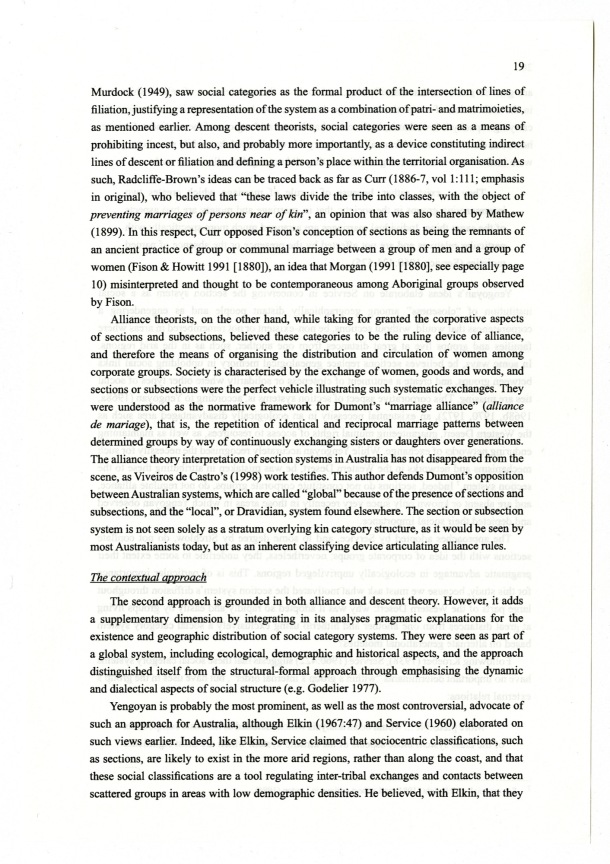|
| 
[Note: this transcription was produced by an automatic OCR engine]
19
Murdock 1949, saw social categories as the formal product of the intersection of lines of
filiation, justifying a representation of the system as a combination of patri- and matrimoieties,
as mentioned earlier. Among descent theorists, social categories were seen as a means of
prohibiting incest, but also, and probably more importantly, as a device constituting indirect
lines of descent or filiation and defining a person’s place within the territorial organisation. As
such, Radcliffe-Brown’s ideas can be traced back as far as Curr 1886-7, vol 1:111; emphasis
in original, who believed that “these laws divide the tribe into classes, with the object of
preventing marriages of persons near of kin”, an opinion that was also shared by Mathew
1899. In this respect, Curr opposed Fison’s conception of sections as being the remnants of
an ancient practice of group or communal marriage between a group of men and a group of
women F ison Howitt 1991 [1880], an idea that Morgan 1991 [I880], see especially page
10 misinterpreted and thought to be contemporaneous among Aboriginal groups observed
by Fison.
Alliance theorists, on the other hand, while taking for granted the corporative aspects
of sections and subsections, believed these categories to be the ruling device of alliance,
and therefore the means of organising the distribution and circulation of women among
corporate groups. Society is characterised by the exchange of women, goods and words, and
sections or subsections were the perfect vehicle illustrating such systematic exchanges. They
were understood as the normative FRAMEWORK for Dumont’s “marriage alliance” alliance
de mariage, that is, the repetition of identical and reciprocal marriage patterns between
determined groups by way of continuously exchanging sisters or daughters over generations.
The alliance theory interpretation of section systems i.n Australia has not disappeared from the
scene, as Vrveiros de Castro’s 1998 work testifies. This author defends Du.mont’s opposition
between Australian systems, which are called “global” because of the presence of sections and
subsections, and the “local”, or Dravidian, system found elsewhere. The section or subsection
system is not seen solely as a stratum overlying kin category structure, as it would be seen by
most Australianists today, but as an inherent classifying device arficulating alliance rules.
The contextual approach
The second approach is grounded in both alliance and descent theory. However, it adds
a supplementary dimension by integrating in its analyses pragmatic explanations for the
existence and geographic distribution of social category systems. They were seen as part of
a global system, including ecological, demogaphic and historical aspects, and the approach
distinguished itself from the structural-formal approach through emphasising the dynamic
and dialectical aspects of social structure e.g. Godelier 1977.
Yengoyan is probably the most prominent, as well as the most controversial, advocate of
such an approach for Australia, although Elkin 1967:47 and Service 1960 elaborated on
such views earlier. Indeed, like Elkin, Service claimed that sociocentric classifications, such
as sections, are likely to exist in the more arid regions, rather than along the coast, and that
these social classifications are a tool regulating inter—tribal exchanges and contacts between
scattered groups in areas with low demographic densities. He believed, with Elkin, that they
|